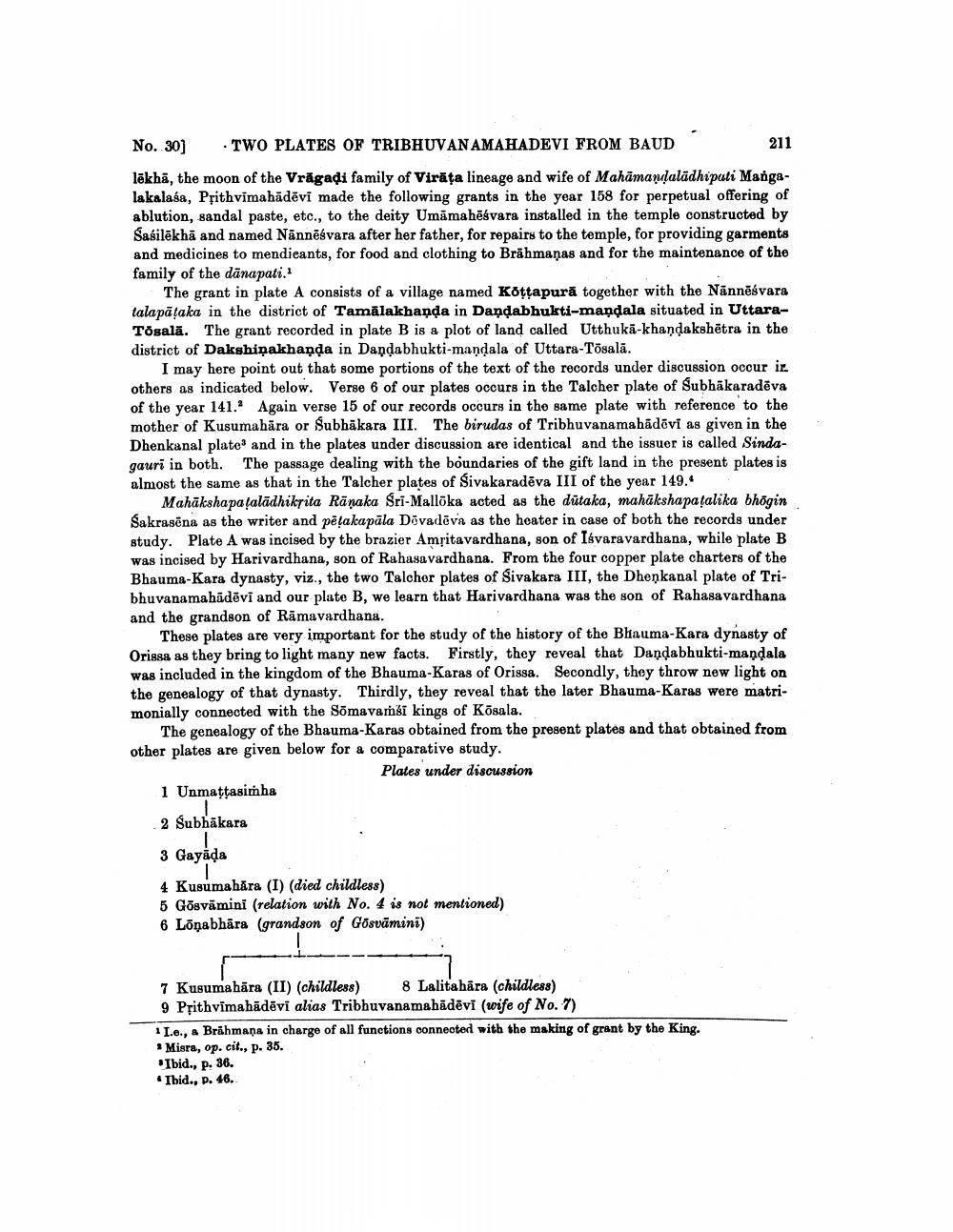________________
No. 30)
. TWO PLATES OF TRIBHUVANAMAHADEVI FROM BAUD
211
lēkhã, the moon of the Vrågadi family of Virāta lineage and wife of Mahāmandalādhiputi Mangalakalasa, Prithvimahādēvi made the following grants in the year 158 for perpetual offering of ablution, sandal paste, etc., to the deity Umamahēšvara installed in the temple constructed by Sabilēkha and named Nännēsvara after her father, for repairs to the temple, for providing garments and medicines to mendicants, for food and clothing to Brāhmanas and for the maintenance of the family of the dāna pati.
The grant in plate A consists of a village named Kottapurā together with the Nānnēsvara talapātaka in the district of Tamālakhanda in Dandabhukti-mandala situated in UttaraTosalā. The grant recorded in plate B is a plot of land called Utthukā-khandakshētra in the district of Dakshinakhanda in Dandabhukti-mandala of Uttara-Tösalā.
I may here point out that some portions of the text of the records under discussion occur iz others as indicated below. Verse 6 of our plates occurs in the Talcher plate of Subhākaradēva of the year 141. Again verse 15 of our records occurs in the same plate with reference to the mother of Kusumahāra or Subhākara III. The birudas of Tribhuvanamahädövi as given in the Dhenkanal plates and in the plates under discussion are identical and the issuer is called Sindagauri in both. The passage dealing with the boundaries of the gift land in the present plates is almost the same as that in the Talcher plates of Sivakaradēva III of the year 149.
Mahākshapatalādhikrita Rānaka Sri-Mallöka acted as the dutaka, mahäkshapatalika bhögin Sakrasēna as the writer and pēļakapāla Dövadēva as the heater in case of both the records under study. Plate A was incised by the brazier Amritavardhana, son of Isvaravardhana, while plate B was incised by Harivardhana, son of Rahasavardhana. From the four copper plate charters of the Bhauma-Kara dynasty, viz., the two Taloher plates of Sivakara III, the Dhenkanal plate of Tribhuvanamahādēvi and our plate B, we learn that Harivardhana was the son of Rahasavardhana and the grandson of Rāmavardhana.
These plates are very important for the study of the history of the Bhauma-Kara dynasty of Orissa as they bring to light many new facts. Firstly, they reveal that Dandabhukti-mandala was included in the kingdom of the Bhauma-Karas of Orissa. Secondly, they throw new light on the genealogy of that dynasty. Thirdly, they reveal that the later Bhauma-Karas were matrimonially connected with the Sõmavamsi kings of Kõsala.
The genealogy of the Bhauma-Karas obtained from the present plates and that obtained from other plates are given below for a comparative study.
Plates under discussion 1 Unmaţtasimha 2 Subhākara
3 Gayada
4 Kusumahăra (I) (died childless) 5 Gösvāmini (relation with No. 4 is not mentioned) 6 Lõnabhāra (grandson of Gosvamini)
7 Kusumahāra (II) (childless) 8 Lalitahāra (childless) 9 Prithvimahādēvi alias Tribhuvanamahādēvi (wife of No. 7) 1 I..., a Brahmana in charge of all functions connected with the making of grant by the King.
Misra, op. cit., p. 35. Ibid., p. 36. Ibid., P. 46.




